Aloha, 2023! A look back at the year that was
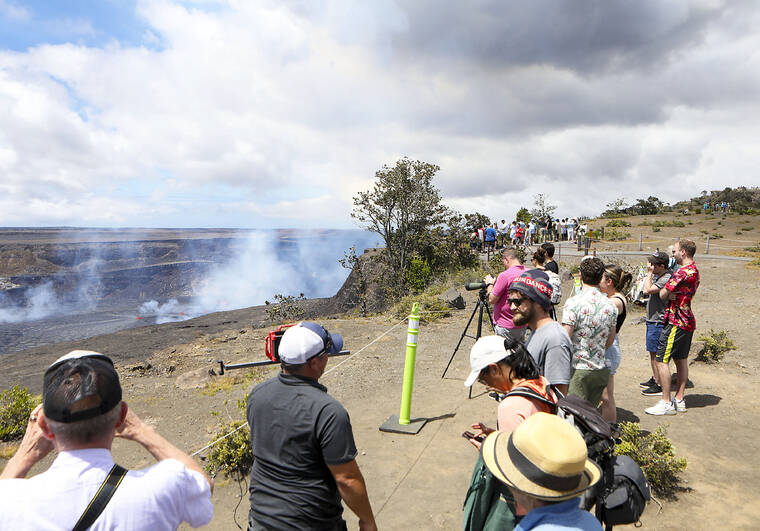
Kelsey Walling/Tribune-Herald Visitors line the side of Kilauea Overlook on June 7 to view the Kilauea eruption in the Halema'uma'u Crater in Hawaii Volcanoes National Park.
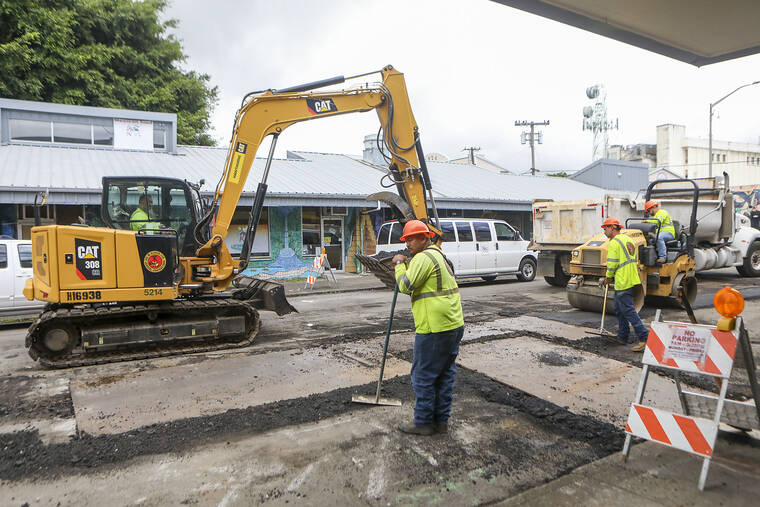
Kelsey Walling/Tribune-Herald Workers cover holes after the installation of gas lines on July 27 on Keawe Street in Hilo.
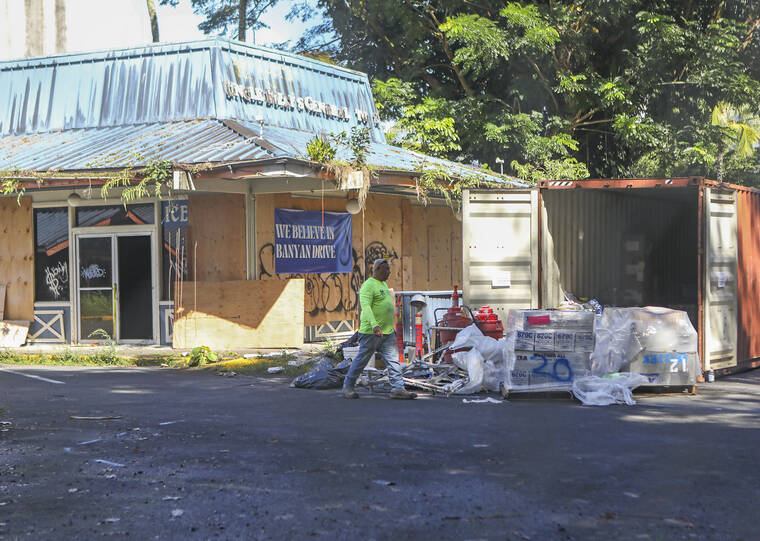
Kelsey Walling/Tribune-Herald A worker with Unitek Contracting Group organizes materials on Dec. 5 as work to clear asbestos from Uncle Billy's Hilo Hotel continues in Hilo.
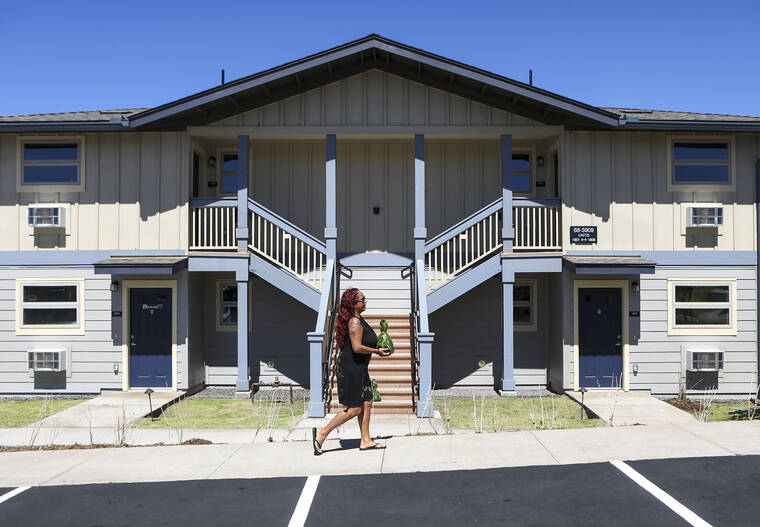
Kelsey Walling/Tribune-Herald A resident brings a traditional Hawaiian pu'olo, containing an offering, during the Oct. 25 dedication of the newly finished Waikoloa Family Affordable complex in Waikoloa Village.
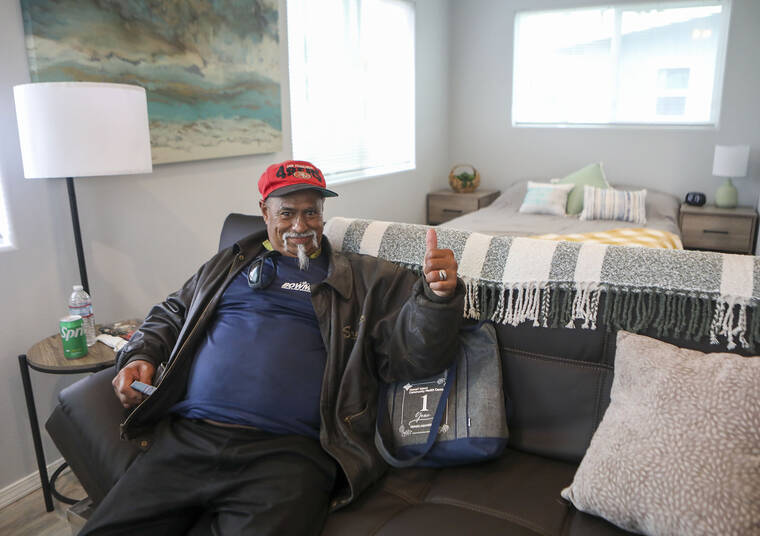
Kelsey Walling/Tribune-Herald Walter Silva gives a thumbs-up in his new home on Nov. 8 during the opening of the Sacred Heart Affordable Housing Project in Pahoa.





For many, 2023 will be remembered as the first full-fledged post-COVID-19 year since 2019.
For many, 2023 will be remembered as the first full-fledged post-COVID-19 year since 2019.
But for some on the Big Island, 2023 might be recalled as the year that two brothers who were convicted of a rape and murder that shook the community to its core more than three decades ago were exonerated. It also was a year marked by progress on affordable housing, homelessness, downtown Hilo’s streets, Puna’s recovery from the 2018 eruption of Kilauea, and more. Unfortunately, 2023 also could be viewed as the year a deadly new threat moved to the forefront: the drug known as fentanyl.
ADVERTISING
As with every year, a few of our most prominent citizens departed. Our list is shorter than usual, however. It includes: Jimmy Yagi, 88, the University of Hawaii at Hilo basketball coach who transitioned the Vulcans from a club program to a small-college intercollegiate powerhouse and retired with a 218-87 record in 12 seasons; singer-guitarist Walter “Bruddah Waltah” Aipolani, 68, whose popularity as the “Father of Hawaiian Reggae” stretched statewide and beyond; Leina‘ala Ann Teruya Drummond, 77, a former Miss Hawaii and model for the face of “Pualani,” Hawaiian Airlines’ iconic “Flower of the Sky” logo; and research geophysicist Jim Kauhikaua, 72, the first Native Hawaiian scientist at Hawaiian Volcano Observatory and the federal facility’s former scientist-in-charge.
And as we ring out 2023 and usher in 2024, here are the Big Island’s top 10 news stories for the past year, as selected by the editorial staff of the Tribune-Herald.
Lookin’ for a home
The lack of housing, especially affordable housing, continues to plague Hawaii. Government and nonprofit organizations, however, are trying to rectify the situation, and Gov. Josh Green has stated a goal of 50,000 new houses to be built.
The Sacred Heart Affordable Housing Project in Pahoa was dedicated in November. It was described by its owners and managers, Hope Services Hawaii, as a “community of 12 prefabricated modular homes and resource center, serving as affordable housing for kupuna.”
The Waikoloa Family Affordable complex was dedicated in October. It features 39 one-bedroom units, 40 two-bedroom flats and 31 two-bedroom townhouses. The units are housed in eight two-story buildings with four units each and 10 two-story buildings with eight units each.
Work continues on Hale Na Koa ‘O Hanakahi, a veteran-focused senior housing project on a 5.6-acre lot on Kawili Street across from the University of Hawaii at Hilo campus.
Slated for completion in June or July, Hale Na Koa will offer 92 single-bedroom units of affordable housing for Big Island seniors, with a preference toward veterans and their spouses, plus a 157-stall parking lot, community center, coffee bar, fitness room and laundry facilities.
At last report, the nonprofit Hawaii Island Community Development Corp. was still seeking funding for Hale Ola O Mohouli, a planned housing project that would build 90 units on a state-owned nine-acre lot on Mohouli Street. The project would be targeted toward low- to moderate-income seniors and families.
In November, more than $17 million in Hawaii County funding was appropriated for seven planned affordable housing projects.
And a gift by Marc Benioff, CEO of the software company Salesforce, and his wife, Lynne, to HICDC includes 282 acres solely for residential use by low- and moderate-income households at Ouli in North Hawaii. The Benioffs also have pledged $8 million to the nonprofit.
Gimme shelter
While the actual number of homeless people on Hawaii Island is unknown, the results of homelessness are apparent every day on the streets of Hilo and Kailua-Kona.
The 2023 Point in Time count — almost certainly an undercount — recorded a 26-person increase in the number of homeless who are in shelters, to 653, while the number of unsheltered homeless increased by 148 people to 1,542,
Green in January signed the first emergency proclamation on homelessness, allowing for construction of up to 12 kauhale villages of tiny homes statewide in the coming years. Green in May opened the first medical kauhale, Pulama Ola, near the governor’s residence at Washington Place in Honolulu.
The County Council in December earmarked almost $10 million to 16 providers of services to the homeless to cover 22 projects, from permanent housing to substance abuse and mental health treatment for those needing help connecting to stable housing opportunities.
Officials in all counties, including Hawaii County, are awaiting a forthcoming decision on a lawsuit brought by ACLU Hawaii against the City and County of Honolulu on behalf of five homeless individuals. The suit alleges that Honolulu’s homeless sweeps and other “anti-houseless” laws should be ruled illegal and unconstitutional because they violate Hawaii’s state constitutional prohibitions against cruel and unusual punishment.
Hawaii County conducted at least two homeless sweeps in 2023, both in Kona — one on May 24, evicting 23 homeless people at Hale Halawai Beach Park, and another on June 7 fronting the county’s Kona Aquatics Center.
The second sweep occurred after ACLU Hawaii Legal Director Wookie Kim sent a letter to Mayor Mitch Roth, Police Chief Benjamin Moszkowicz, Parks and Recreation Director Maurice Messina and Corporation Counsel Elizabeth Strance, demanding the county stop the sweeps without providing adequate shelter space — or face legal action.
Sweet freedom
It took almost a decade to convict three Native Hawaiian men for the shockingly brutal Christmas Eve 1991 kidnapping, rape and murder of Dana Ireland, a 23-year-old from Springfield, Va., who died hours after being found barely clinging to life on a fishing trail in lower Puna.
It took another two-plus decades for Hilo Circuit Judge Peter Kubota to rule that two brothers, Albert “Ian” Schweitzer and Shawn Schweitzer, were wrongly convicted in perhaps the most notorious murder in Hawaii’s history.
Kubota’s rulings were also de facto exoneration for Frank Pauline Jr., who implicated the Schweitzers and himself in a confession he later recanted. Pauline was murdered on his 42nd birthday in 2015 a New Mexico prison yard by a fellow inmate, a day after the Tribune-Herald reported the Hawaii Innocence Project was representing Ian Schweitzer.
In January, Kubota ruled that DNA and other evidence exonerated the 51-year-old Ian Schweitzer, who was serving 130 years for Ireland’s murder, and ordered he “be released from his shackles immediately.”
DNA found on several key pieces of evidence in the case — including the bloody blue “Jimmy Z” brand T-shirt three witnesses testified was worn by Pauline the day of the murder — belongs to an individual referred to in court as “Unknown Male No. 1.” No DNA from the Schweitzers or Pauline was present.
Shawn Schweitzer’s day in court came in late October, and his manslaughter conviction was expunged. The younger Schweitzer — a minor when the incident occurred but charged as an adult — took a plea deal and made a false confession that freed him from incarceration with time already served, but cast a shadow over him for more than two decades.
Shortly after Ian Schweitzer was cleared, Moszkowicz and county Prosecutor Kelden Waltjen released separate statements saying they remain committed to finding Ireland’s killer and bringing that individual to justice.
A petition to clear Pauline posthumously, filed by Honolulu attorney Myles Breiner, is expected to be heard by Kubota on Jan. 25.
$50 million for Hilo’s hospital
The state’s most recent budget bill allocated $50 million, requested by Green, for the first phase of a large expansion of Hilo Medical Center.
Planned are increases in patient capacities in the Intensive Care Unit from 11 to 30 and the Patient Care Unit from 15 to 51.
Both units will be located in a new three-story structure to be built above the current physician and visitor parking area that is adjacent to the hospital. Construction is planned to start at the beginning of 2024.
HMC’s patient capacity has not changed since its construction in 1985, despite the Big Island’s rapid growth over the last 38 years.
A final environmental assessment for the HMC expansion project has been published.
Peninsula plans under water?
The state and county are in preliminary stages of assessing the best use of the roughly 79 acres of state-owned land on Hilo’s Waiakea Peninsula.
Two major Banyan Drive properties — the former Uncle Billy’s Hilo Bay Hotel and the former Country Club Condominium Hotel — have fallen into disrepair. The Uncle Billy’s site, which was essentially taken over by squatters, is now fenced off and awaiting demolition, which is expected to occur in early 2024.
State and county authorities have agreed a more concrete management plan for the area is essential. But in a Dec. 5 meeting, four proposals outlined by a private consultant contracted by the Department of Land and Natural Resources — three based on East Coast urban waterfront parks — were given a chilly reception by attendees, who pointed out that Hilo is neither Florida nor Brooklyn. A fourth proposal, based on a series of developments in New Zealand that emphasized indigenous Maori culture, was looked upon more favorably. But the consultant was showered with derisive laughter when she noted “Captain Cook landed here.”
Some attendees pointed out that with global warming and sea-level rise, DLNR should make plans to abandon the peninsula. One suggested aquaculture or fish ponds.
On the road again
Restoration of a portion of Highway 137 in lower Puna, which was covered by lava in 2018, cleared a major hurdle with the Federal Emergency Management Agency, which published its final environmental assessment for the project.
The EA found the project would have no significant environmental impact, one of the last steps needed before the county can begin construction.
Jen Myers, spokeswoman for the county’s Disaster Recovery office, said she is confident work on the first phase of the project will begin in the first quarter of 2024.
FEMA is contributing 75% of the construction costs, with the county chipping in 25%.
The final EA included only one substantial change to the project: It rearranged its four phases, with one phase shifted from the first phase to the last.
That phase, which will restore a portion of Lighthouse Road from the “Four Corners” intersection at Highway 137, was moved back following public concerns about visitor impacts to Kumukahi’s cultural resources — including Hawaiian burial sites — that were raised after the draft EA was published in August.
Myers said county officials met with Native Hawaiians and FEMA to explain what was at stake at Kumukahi. She said that although the situation was unusual compared to what FEMA typically deals with, the agency was receptive to the community’s input.
Shifting the Lighthouse Road phase to the end of the project hasn’t significantly changed the timeline for the other phases. The new first phase, which will restore a stretch of Highway 137 from “Four Corners” to Kapoho Beach Road, will begin in early 2024 and should end by fall.
One pill can kill
While methamphetamine continues to be a concern for law enforcers and health officials, fentanyl has become Public Enemy No. 1 among street drugs.
The synthetic opioid is reportedly 50 times stronger than heroin and 100 times stronger than morphine. Illegal drug distributors often mix fentanyl with other drugs because it’s cheap and potent. Just 2 milligrams — the equivalent of a few grains of table salt — can be lethal, according to the Drug Enforcement Administration.
Through November, police made 33 fentanyl-related arrests in East Hawaii and 31 in West Hawaii. Seized were 518.9 grams of fentanyl and 6,798.5 pills containing the drug. In West Hawaii, 645.77 grams of the drug were seized, plus 1,025 fentanyl-laced pills.
The most publicized fentanyl death of a Big Islander in 2023 was that of Steven Berengue, a 53-year-old canoe paddler and coach from Kailua-Kona, who died in June after police and medics responded to a mass overdose in a Waikiki hotel room. Five people were said by Honolulu police to have OD’d after ingesting fentanyl they thought was meth. Another man, 44-year-old Joseph Iseke of Kailua, Oahu, also died. Berengue’s wife, Siulin, reportedly was one of the three who survived.
Four people have been indicted for allegedly distributing the drugs in the case.
In an effort to stem the damage, the Hawaii Island Fentanyl Task Force provided the county with 150 Narcan (naloxone) kits — a nasal spray that can reverse an opioid overdose — for distribution to its facilities. And in July, the county Department of Liquor Control distributed more than 700 doses of naloxone to Big Island bars, restaurants, nightclubs and hotels.
Insurance at a premium
Fallout from the 2018 lava flow continues to plague lower Puna homeowners, according to the 200-plus who attended an August meeting at the Hawaiian Shores Community Center.
At least one insurer, Florida-based carrier Universal Property and Casualty Insurance Co., has left the Hawaii market, affecting about 900 Big Island policyholders. And some residents of lava zones 1 and 2 told state Insurance Commissioner Gordon Ito their premiums rose 400% or higher — and that has priced many out of their homes.
The state-run Hawaii Property Insurance Association, a last-resort underwriter for those unable to find another carrier, is now the only option for many.
Ito said HPIA lost $5 million after the 2018 Kilauea eruption. He added the reasons for HPIA’s high premiums include the increased cost of building materials and supply chain issues that cropped up during the COVID pandemic, a loss in reserves following the 2018 lava flow, and an increased cost of reinsurance — the insurance that a provider secures to cover risk.
This follows a raft of lawsuits against Lloyd’s of London and its underwriters for nonpayment of claims for property destroyed during the 2018 eruption. Plaintiffs Michael Hale and Greg and Carol Dencker are appealing the dismissal of their civil suit by Hilo Circuit Judge Henry Nakamoto. The appeal was filed Dec. 22 after the state Supreme Court denied their petition for a writ of mandamus directed at Nakamoto, which, if granted, would’ve ordered the judge reconsider claims by the plaintiffs that Lloyd’s engaged in price-fixing of policies with its Hawaii underwriters.
Takin’ it to the streets
A $12.3 million, 16-month-long rehabilitation project for portions of Kilauea Avenue and Keawe Street has made driving in downtown Hilo inconvenient, at best.
The federally funded project, which began in April, aims to improve Kilauea and Keawe between Ponahawai Street and Waianuenue Avenue. In addition to paving, lane striping and sidewalk improvements, the rehabilitation includes improvements to buried water and sewer lines.
The work is being done at night, but those driving in the daytime run a chassis-rattling obstacle course of steel plates and pockmarked pavement.
Department of Public Works Engineering Division Chief Keone Thompson told the Tribune-Herald the project is “the most expensive one-third of a mile project (he’s) ever done.”
After the project’s completion — projected for August 2024 — the county will convert a construction staging area at the corner of Ponahawai and Kilauea to a public parking lot.
Tourism makes a comeback
Visitor arrivals, which went to almost zero during the lockdown phase of the COVID pandemic, have now returned to near prepandemic levels.
According to the Hawaii Tourism Authority, just more than 1.6 million visitors arrived on Hawaii Island via air through November, a 6.3% increase over 2022 and a statistical wash, with air arrivals in the first 11 months of 2019, the last pre pandemic year.
Of those, the vast majority — 1.41 million — arrived in Kona, which has direct mainland flights, as opposed to 527,000 visitor arrivals in Hilo. The Hilo side, however, had the bigger increase over 2022, 15.4%, as opposed to a 6.8% increase in Kona.
The average length of stay in Hawaii was just under nine days.
Visitors to the Big Island on international flights numbered just more than 161,000, a 76% increase over the 91,500 that arrived in 2022 but far shy of the 376,000 that arrived in 2019.
Email John Burnett at jburnett@hawaiitribune-herald.com.





